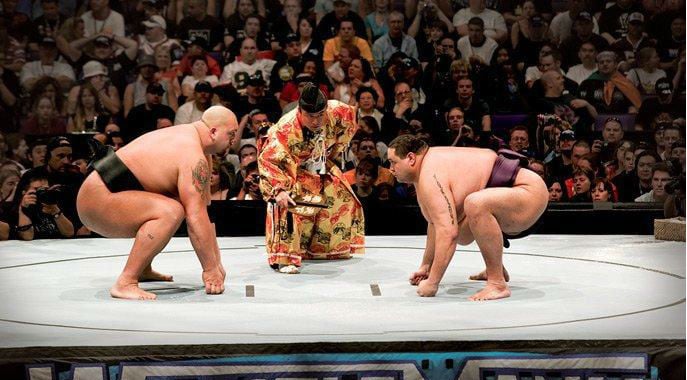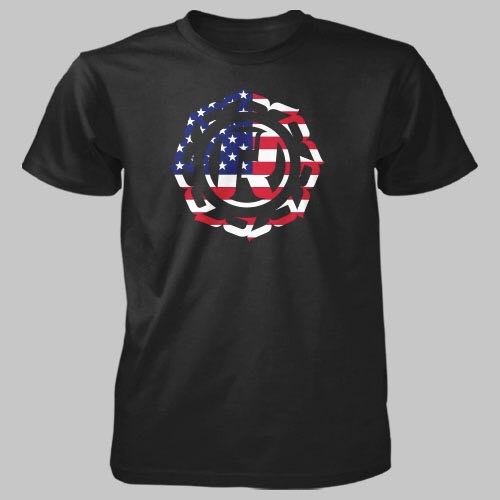Real Shooters: Big Show vs. Akebono, WrestleMania 21

RondaRousey.com’s Real Shooters feature explores the good, the bad, and the weird of pro wrestling-MMA crossover moments in history.
There’s a long history of professional athletes making guest appearances at WrestleMania, from Mike Tyson to Gronk. Usually, WWE fans understand that these celebrities are there to add to the excitement of a special attraction, to bring publicity to the event, and to draw some viewers who might not otherwise watch. However, at WrestleMania 21 in 2005, WWE brought in a special guest sports star who most viewers had probably never seen or heard of before when sumo grand champion Akebono made his pro wrestling debut against the Big Show.
In the spring of 2005, Big Show was not the highest-level wrestler in WWE, but his size clearly established him as a threat. His physical uniqueness made him a logical choice to play a part in a “special attraction” type of match, but he wasn’t someone fans would be shocked and appalled to see lose to a guest star. A few years later he would face another pro athlete, Floyd Mayweather, at WrestleMania in a match that pit boxer vs. wrestler, size vs. speed. At WrestleMania 21, Show was half of a match with a lesser-known (in America) combat sports star that was all about size vs. size: a sumo wrestling match with the legendary Akebono.
“Akebono” was the pro wrestling name of Akebono Tarō, which was the sumo wrestling ring name (shikona) of Chad Rowan. Basketball was Rowan’s sport of choice when he was growing up, but he eventually developed an interest in sumo and fully committed to training. He moved from Hawaii to Japan and made his sumo debut in 1988.

Akebono quickly found success in the sport and in 1991—at the age of 23—was recommended for promotion to the rank of “yokozuna,” the highest possible for a sumo wrestler. This accomplishment received international news coverage because he was the first man promoted to yokozuna who was not ethnically Japanese.
Akebono becoming the first non-Japanese yokozuna was a big deal not just because of his accomplishments as a wrestler, but because he overcame cultural biases against foreigners competing in sumo at a high level. Sumo is both a contact grappling sport, but it’s also a tradition that’s been practiced for over 1,000 years. Its roots in Shinto Buddhist ritual can still be seen through ceremonial aspects of the sport, like the pre-match cleansing of both the ring and the wrestlers.
Sumo training also involves not just bulking up and working out but living a stoic lifestyle. Like in many sports organizations, rookies are tasked with more strenuous chores than the more experienced athletes. However, sumo takes this to another level, with wrestlers having to move up in the ranks in order to do things like move out of the dojo, get married, or own a cellphone.
Similarly, rising in the sumo ranks isn’t only accomplished through athletic achievements. In addition to a strong record and displays of wrestling skill and physical strength, a wrestler as high in the ranks as a yokozuna—one of the public faces of the sport—also needs to display “hinkaku,” dignity or honor. It was also hinkaku that created a ceiling for foreign wrestlers in sumo.
These issues, which were discussed more openly around the time of Akebono’s promotion, were summed up in a 1993 New York Times article:
“Some purists say that foreigners can never attain the aura of dignity, known as hinkaku, that is as necessary for a yokozuna as strength and skill. Others fear that the national sport might be overrun by foreigners.
‘Sumo is above all a ritual, secondly a drama and thirdly a sport,’ Yoshitaka Takahashi, the former chairman of the Yokozuna Promotion Council, was quoted as saying today by Japanese newspapers. He said a foreign grand champion was as hard to imagine as a foreign master of Japanese ‘noh’ drama.”
But despite this controversy, Akebono maintained his popularity after his promotion and even represented Japan in the opening ceremony of the 1998 Winter Olympics in Nagano. Multiple non-Japanese sumo wrestlers have attained the rank of yokozuna since.
Akebono retired from sumo in 2001 due to injury, but financial difficulties led to his return to the combat sports world in 2003, this time for MMA organization K-1 rather than sumo. He lost his first fight against Bob Sapp by knockout in under three minutes and never achieved much success in kickboxing or MMA. Akebono would eventually become a semi-regular fixture in some Japanese pro wrestling promotions, but before that, in 2005, he beat the Big Show in his first and only wrestling match in the United States.
Though Big Show went as far as to flip over a Jeep to send a message to his WrestleMania opponent, it always looked like Akebono had the advantage. On the last WWE show before the pay-per-view, Big Show and Akebono had a weigh-in and Akebono out-weighed Show by eleven pounds (504 to 493). Big Show, who had just been outweighed for the first time in his WWE career, then witnessed Akebono absolutely destroy a much smaller wrestler in “a WWE-style” match.
At WrestleMania, it was even clearer that Show was out of his element. As both men made their entrances in Japanese robes, Michael Cole summarized Akebono’s athletic background and commentary and Tazz talked about his badassery. The rules of the match were simple—“To be declared the winner, you must either push your opponent out of the circle or knock him off his feet”—but, as Tazz pointed out, Big Show had no experience with said rules, while Akebono was known as a master of the sport.
The WWE Superstar’s immediate future did not look bright, and it looked very different from the usual spectacle of WrestleMania. There was a sumo circle painted in the ring, a referee in traditional Japanese garb, and a ritual purifying of the ring with salt. Though multiple WWE wrestlers had used sumo terminology for their ring names in the past (Rikishi, Yokozuna), the exhibition of sumo wrestling could have hardly clashed more with the rowdiness of the Ruthless Aggression Era WWE crowd.
However, the actual clash of “nearly a half-ton of humanity” wasn’t too out-of-place. Big Show and Akebono tried to psych each other out by turning their backs to each other, exchanged open-hand palm strikes, and locked up, grabbing each other’s mawashi (sumo wrestling belt or loincloth) for leverage. They got dangerously close to the edge of the circle and it looked like Show might actually get the shock win. But though he managed to lift his over-500-pound opponent, Akebono countered the move and threw Show out of the circle.
“The quick hits… and the experience of the grand sumo champion,” in commentary’s words, had resulted in a victory for Akebono… and the crowd sounded underwhelmed, or at least quieter than usual. They had just seen under two minutes of wrestling action that ended with a wrestler most of them had never seen before defeating a man whose victory they didn’t care that much about.
Though Big Show vs. Akebono is interesting to watch, it doesn’t leave the viewer surprised that WWE has yet to host another sumo match at WrestleMania. The one at WrestleMania 21 wasn’t a huge hit, but it was a memorable oddity, a unique spectacle, and a memorable installment in the history of pro wrestling/combat sports crossover moments.
You can watch Big Show vs. Akebono (and the rest of WrestleMania 21) on the WWE Network.